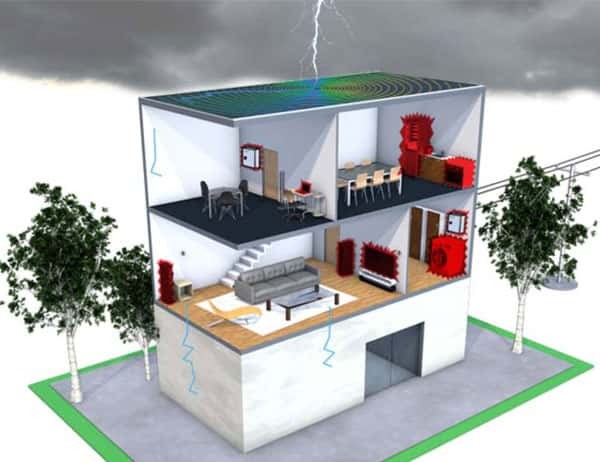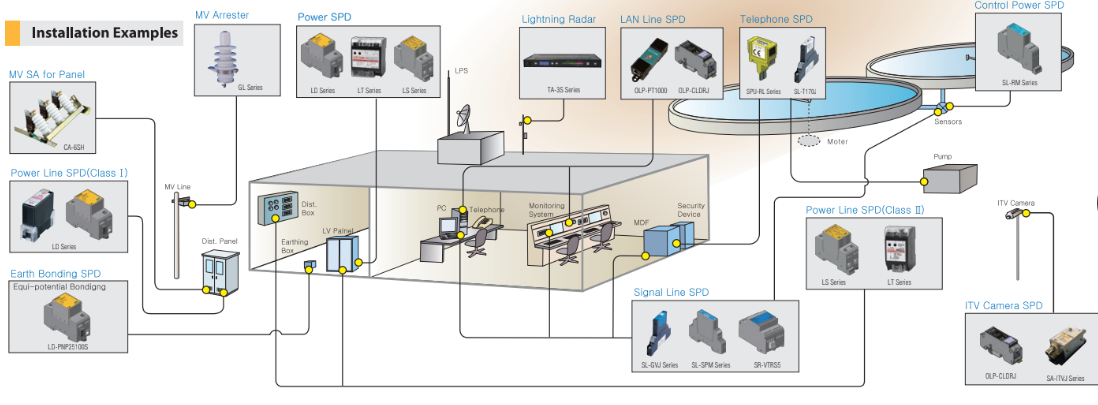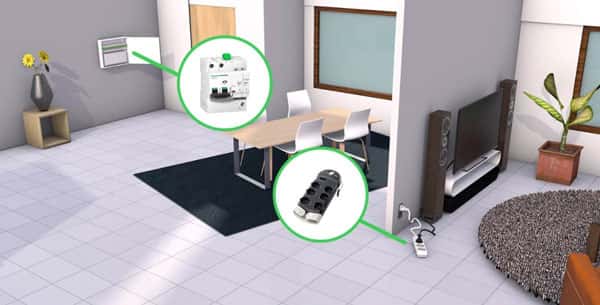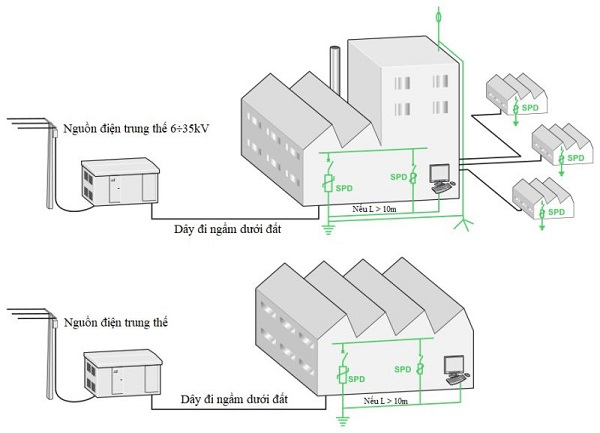What is surge protection? What is surge protection? Why should lightning protection? What are the operating principles and technical requirements when installing and constructing an effective and safe lightning protection system? Let’s find out more details with P69 Company through the following article!
What is lightning spread?
Transmitted lightning is when a lightning strikes a certain location, within a radius of 2km from the location of the lightning strike, it will electromagnetically induce electrical wires, metal objects, and data transmission lines nearby leading to damaged.
1. Statistics of lightning transmission
According to statistics on the phenomenon of lightning transmission:
- Every day around the world there will be about 8 million lightning bolts.
- The highest structure is the point of contact with the possibility of being struck by lightning.
- Despite the fact that some structures are more likely to attract lightning, lightning is unpredictable.
2. Risk of damage to electronic devices

High surge voltage has the potential to enter the home through direct or indirect lightning strikes. For direct lightning, the lightning goes straight through the building, causing serious damage to the factory, while for indirect lightning, the lightning strikes the adjacent ground, the power line connects directly to the house. When this happens, any electronic equipment can be destroyed.
The result: Not only high replacement costs for electronic devices and circuits, but also disrupted connections to personal devices.
3. Simulate the path of lightning
When lightning strikes close to an unprotected building, it travels inside through a power line that connects directly to the switchboard. When lightning strikes a building with a lightning rod, the voltage is transmitted directly to the ground around the house. However, half of the voltage can still enter the house through the electrical circuit.
What is surge protection?
Surge protection is an activity of arranging lightning arresters and filters in order to limit the sudden surge overvoltages that propagate on power or signal lines by redirecting this dangerous current to another place (grounding ground). safely.
What is a surge arrester? Is a device designed to help protect electromagnetic devices, voltage surges. The purpose is to limit the increase of supply voltage to electrical equipment by drawing to ground when encountering unwanted voltage above the safe threshold.
Surge surge arresters and voltage surge reducers are mainly installed in the main power supply cabinets of buildings, factories, factories, floor distribution electrical panels, right in front of PLC, telecommunications, and receiver equipment. – signal generation, IT,… protection against voltage and current fluctuations, even in the event of a lightning strike.
Working principle of surge arrester
The operating principle of the surge arrester is based on the protection circuit principle. When lightning strikes the system, the device will immediately perform the lightning protection function. Through the filter, they suppress the noise of lightning on electrical equipment to protect the overvoltage and overload of the line without short-circuiting.
Based on the 2-phase or 3-phase power supply to select the protection mode for the surge arrester: 2 modes, 3 modes, 4 modes, 7 modes, 10 modes.

In the electrical equipment market, the surge protection device of the Schneider brand is considered the best with extremely effective power system protection technologies such as:
- Technology to protect modes
- Thermal fuse technology.
- On-board heat dissipation technology to ensure lightning surge cutting is done safely.
- Eliminate lightning surges effectively.
- Avoid the situation that the electrical system is overloaded or over-voltage
Schneider surge arresters apply advanced sine wave correction technology to prevent lightning from affecting all electrical equipment operations, ensuring stable sine waves and good power supply at all locations. regime.
Classification of Lightning Propagation System
Surge protection devices are divided into 3 types, specifically as follows:
1. SPD Type 1 . Lightning Protection
- Type 1 surge arresters are recommended for use in specific cases such as factories, buildings, industrial plants, etc., which are protected by a lightning protection system or a direct lightning grid cage.
- This device protects the electrical system. Class 1 SPDs are capable of discharging reverse currents due to the backflow of lightning from the ground conductor to the conductors of the mains system.
- Class 1 surge arresters are characterized by a 10/350µs waveform current.
2. SPD Type 2 . Lightning Protection
- Class 2 surge arresters are the main protection system for all low voltage electrical equipment. This device is installed in each electronic to prevent overvoltage propagation in the power system and protect the loads.
- Class 2 surge arresters are characterized by a waveform current of 8/20µs.
3. SPD Type 3 . Lightning Protection
- Class 3 surge arresters have a low discharge capacity. For this reason, they must be installed optionally as additional equipment for Class 2 SPDs and in the vicinity of sensitive loads.
- Class 2 surge arresters are characterized by a combination of voltage waves (1.2/50µs) and current waves (8/20µs).
Popular Surge Protection Devices

Schneider surge arrester is a line of high quality, efficient lightning protection products that is being used by many units.
The Schneider surge arrester is a high quality product manufactured on modern lines meeting European standards, bringing accuracy, flexibility as well as the best user experience.
Currently, on the market, customers can find and buy Schneider surge protection devices with models such as:
- Acti 9 . surge arrester
- Easy 9 . surge arrester
Note when installing surge protection
In addition to understanding the principle of surge protection, the following notes will ensure an effective surge protection installation. To optimize the lightning protection system, it is necessary to determine the installation location according to the following criteria:

1. Primary lightning cutting layer
This floor will protect all mechanical equipment in the house. It is necessary to install the primary lightning arrester at the input for large projects. When directly struck by lightning, these floor equipment plays the most important role. It has the maximum lightning breaking capacity, the lightning breaking capacity is satisfactory when more than or equal to 100 kA.
2. Secondary lightning cutting layer
The secondary cut-off stage can reduce residual voltage. This floor is applied to select equipment in distribution cabinets. The secondary lightning cut stage has the function of protecting branch circuit equipment from surge surges. These surges are generated internally from the main circuit by devices in the circuit including: switchgear, pulse interference. Pulse contamination usually accounts for 70–80% of the damage to sensitive electrical and electronic equipment.
3. Circuit of electrical equipment causing interference
Circuits of electrical equipment that cause interference are used to prevent electrical disturbances from returning. It causes damage to devices in other circuits. Circuit of electrical equipment jamming to protect inverter and industrial electrical equipment.
4. Residual voltage of lightning protection device
After being subjected to lightning impulses and surges, this is the remaining voltage. The smaller the residual voltage, the better.
5. Location of electronic equipment
It is necessary to place sensitive equipment at least 9m away from lightning protection equipment. For projects requiring high lightning protection, it is recommended to install additional surge protection devices to protect the input points of use.
Application of surge arresters
After learning what surge protection is, let’s take a look at their applications in the power system with SG Vietnam below.
1. Protection of residential electrical system
In order to protect the family home, it is absolutely necessary to use lightning protection devices for the electrical system in the house, especially in the rainy season. This is considered one of the outstanding applications of surge protection devices, helping to ensure the safety of people and property.
You can use lightning protection devices to ensure the safety of the entire household electrical system. You should choose a separate lightning protection product for each industrial electrical appliance in your home such as: rolling door, laptop, TV, phone, etc. The more electrical equipment you use, the more lightning protection products need to be equipped with. best way.
2. Signal transmission system protection
The device has the ability to effectively filter and dissipate lightning impulses. As a result, they are used in wiring or antenna systems with protection mechanisms for continuous operation, especially on stormy days.
According to experts, the signal transmission system is one of the targets of lightning current. Specifically, up to 75% of signal transmission lines are damaged by lightning strikes. The lightning protection device is now effective in preventing such accidents from happening.
3. Wide application in houses or high-rise buildings
Surge arresters for electrical systems are used in buildings of superior height to prevent accidents from occurring. On the roof of the building, when there is a thunderstorm, the device will cut lightning impulses and effectively prevent interference to ensure safety for people as well as buildings.
In addition, the characteristics of factories and industrial parks are many equipment and machines with high investment costs. It is absolutely essential to protect this equipment from lightning currents. The economic problem posed here is not too difficult to explain, when the investment in lightning protection equipment is only 1/10 of the cost of modern machinery, right?
Contact us today for a free consultation and answer at:
Contact information P69 – M&E . M&E Contractor
Address: No. 6/165C Xuan Thuy, Cau Giay District, Hanoi
Website: https://p69.com.vn/
Hotline: 02422121212 – 0965937799
Email: kd@cokhip69.com.vn
Facebook: https://www.facebook.com/p69nhathaucodien
LinkedIn: https://www.linkedin.com/in/congtyp69/
Youtube : https://www.youtube.com/channel/UCOUwCnE5iGj8iqe_ZIUM7oA

